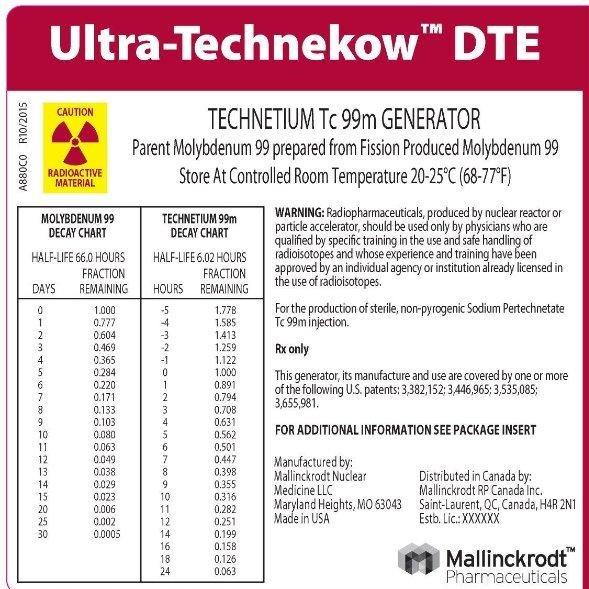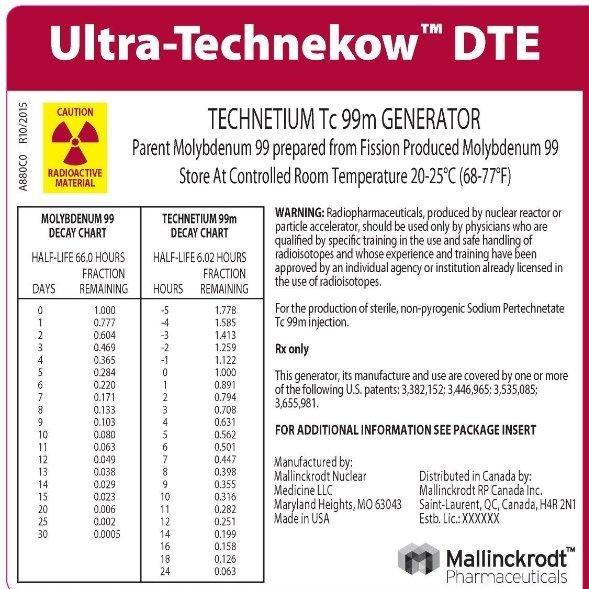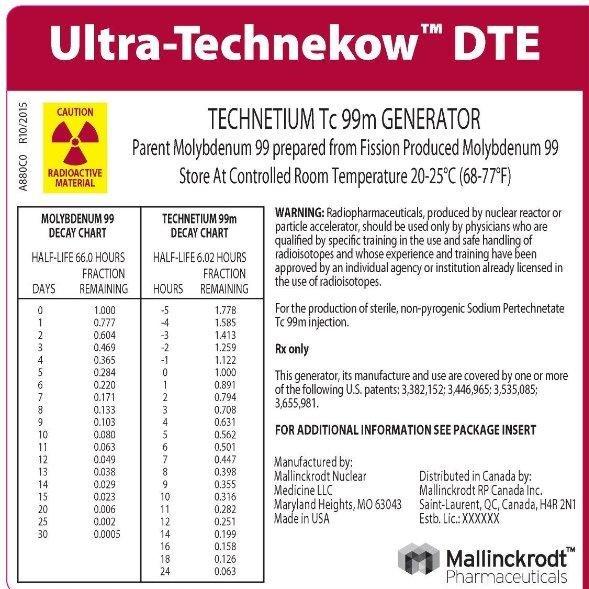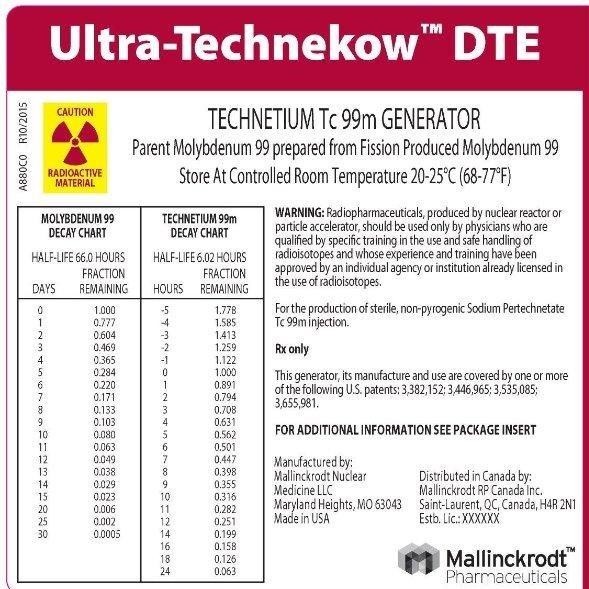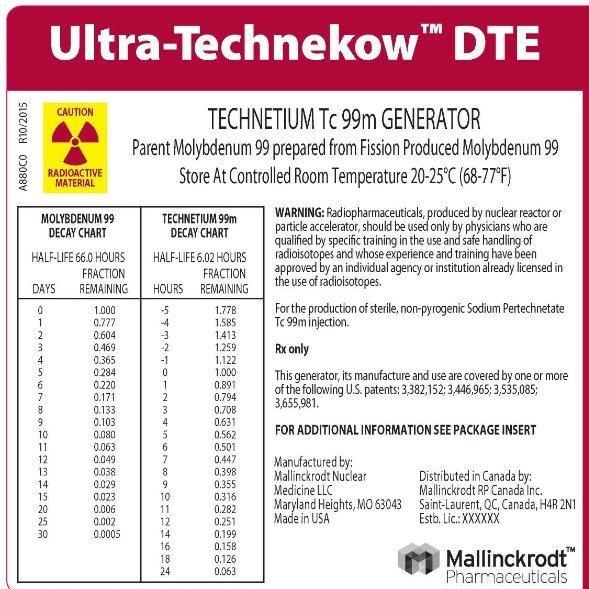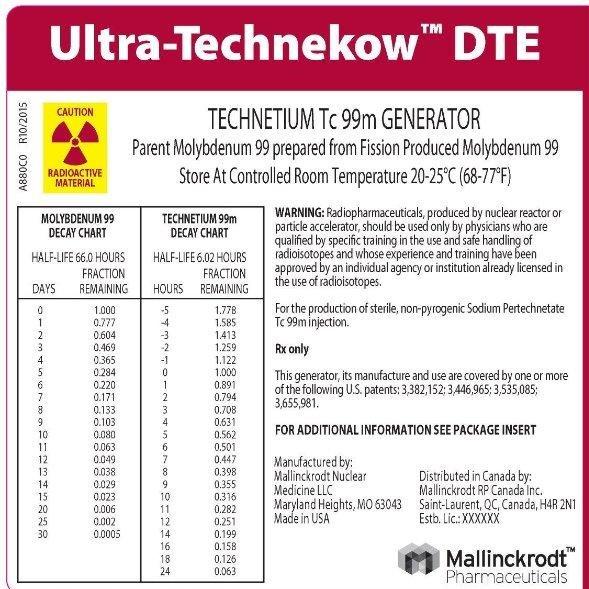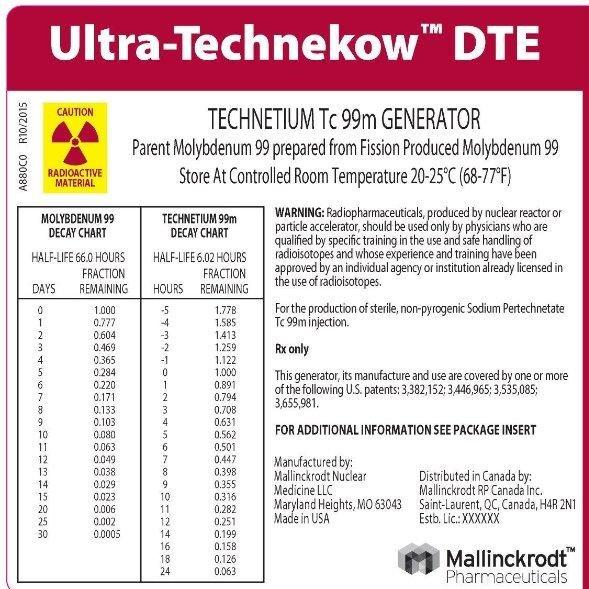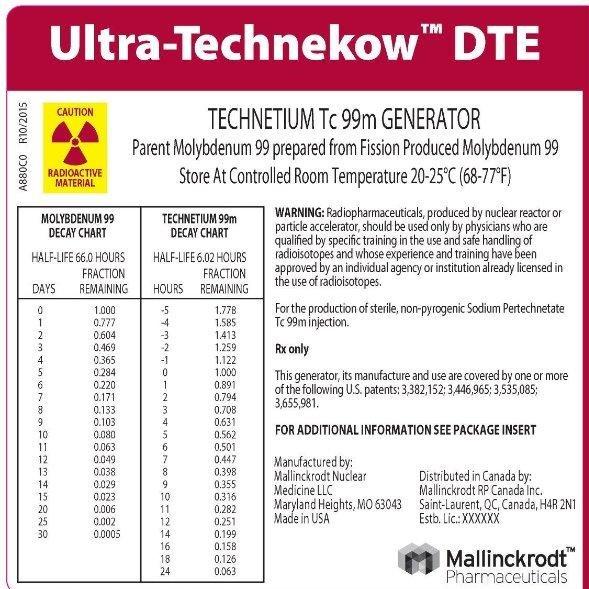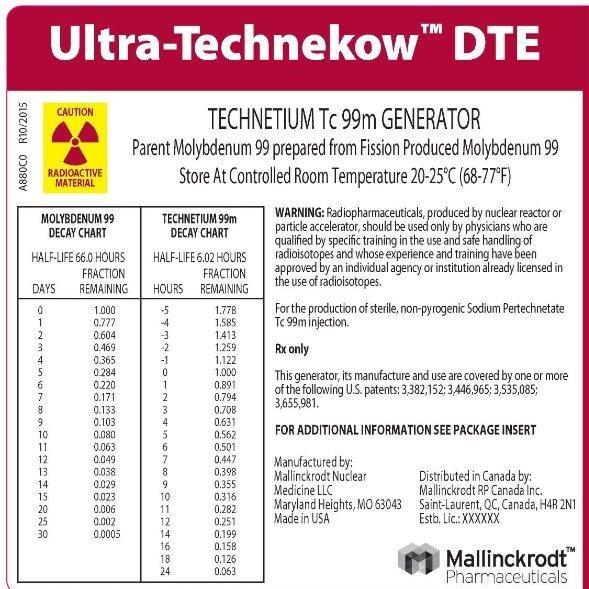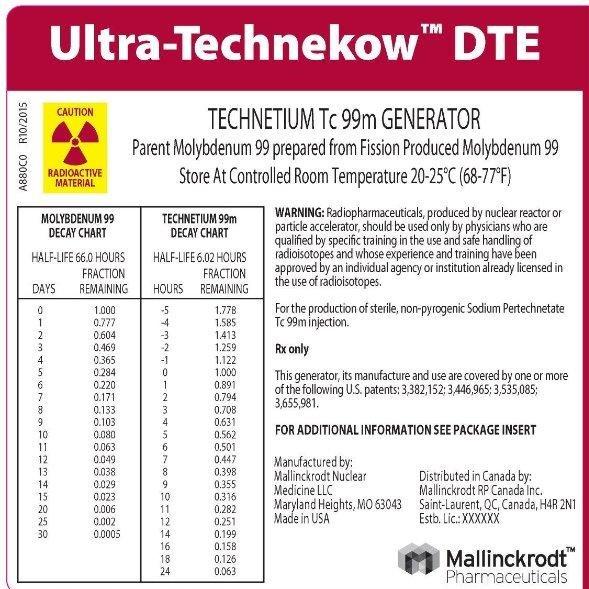ULTRA-TECHNEKOW DTE- technetium tc-99m injection, solution
Ultra-TechneKow by
Drug Labeling and Warnings
Ultra-TechneKow by is a Prescription medication manufactured, distributed, or labeled by Curium US LLC. Drug facts, warnings, and ingredients follow.
Drug Details [pdf]
-
DESCRIPTION
The Ultra-Technekow™ DTE Generator is prepared with fission-produced molybdenum Mo-99 adsorbed onto alumina column shielded by lead, tungsten, or depleted uranium. This generator provides a closed system for the production of sterile metastable technetium Tc-99m, which is produced by the decay of molybdenum Mo-99. Sterile, non-pyrogenic isotonic solutions of Sodium Pertechnetate Tc 99m can be obtained conveniently by periodic aseptic elution of the generator. These solutions should be clear, colorless, and free from any particulate matter.
The carrier-free solution may be used as is, or diluted to the proper concentration. Over the life of the generator, an elution will contain an amount of technetium Tc-99m in direct proportion to the quantity of Mo-99 decay since the previous elution of the generator. The quantity of Tc-99m in the eluate is determined by quantity of Mo-99 on the column and the elapsed time between elutions.
Each eluate of the generator should not contain more than the USP limit of
0.15 kilobecquerel molybdenum Mo-99 per megabecquerel technetium Tc-99m
(0.15 microcurie Mo-99 per millicurie Tc-99m) per administered dose at the time of administration and an aluminum ion concentration of not more than 10 micrograms per milliliter of the generator eluate, both of which must be determined by the user before administration.Since the eluate does not contain an antimicrobial agent, it should not be used after
12 hours from the time of generator elution. - Physical Characteristics
-
External Radiation
The specific gamma ray constant for technetium Tc-99m is 0.795 R/hr-mCi at 1 cm. The first half-value layer is 0.023 cm of lead (Pb). A range of values for the relative attenuation of the radiation emitted by this radionuclide that results from interposition of various thicknesses of Pb is shown in Table 2. For example, the use of 0.27 cm thickness of Pb will attenuate the radiation emitted by a factor of about 1000.
Table 2. Radiation Attenuation
by Lead ShieldingShield
Thickness (Pb) cm
Coefficient
of Attenuation
0.023
0.5
0.09
10-1
0.18
10-2
0.27
10-3
Molybdenum Mo-99 decays to technetium Tc-99m with a molybdenum Mo-99 half-life of 2.75 days, or 66 hours. The physical decay characteristics of molybdenum Mo-99 are such that only 88.6% of the decaying molybdenum Mo-99 atoms form technetium Tc-99m. Generator elutions may be made at any time, but the amount of technetium Tc-99m available will depend on the interval measured from the last elution. Approximately 47% of the maximum available technetium Tc-99m is reached after 6 hours and 95% after
23 hours. To correct for physical decay of molybdenum Mo-99 and technetium Tc-99m, the fractions that remain at selected intervals of time are shown in Tables 3 and 4.Table 3. Physical Decay Chart,
Molybdenum Mo-99, Half-Life 66 HoursDays
Percent Remaining
Days
Percent Remaining
0
100
10
8
1
78
11
6
2
60
12
5
3
47
13
4
4
37
14
3
5
28
15
2
6
22
20
0.6
7
17
25
0.2
8
13
30
0.05
9
10
Table 4. Physical Decay Chart;
Technetium Tc-99m, Half-Life 6 HoursHours
Percent
RemainingHours
Percent
Remaining0*
100
9
35
1
89
10
32
2
79
11
28
3
71
12
25
4
63
14
20
5
56
16
16
6
50
18
13
7
45
24
6
8
40
* Calibration Time
-
CLINICAL PHARMACOLOGY
The pertechnetate ion distributes in the body similarly to the iodide ion but is not organified when trapped in the thyroid gland. Pertechnetate concentrates in the thyroid gland, salivary glands, stomach and choroid plexus. After intravenous administration it gradually equilibrates with the extracellular space. A fraction is promptly excreted via the kidneys.
Following the administration of Sodium Pertechnetate Tc 99m as an eye drop, the drug mixes with tears within the conjunctival space. Within seconds to minutes it leaves the conjunctival space and escapes into the inferior meatus of the nose through the nasolacrimal drainage system. During this process the pertechnetate ion passes through the canaliculi, the lacrimal sac and the nasolacrimal duct. In the event of any anatomical or functional blockage of the drainage system there will be a backflow resulting in tearing (epiphora). Thus the pertechnetate escapes the conjunctival space in the tears.
While the major part of the pertechnetate escapes within a few minutes of normal drainage and tearing, it has been documented that there is some degree of transconjunctival absorption with turnover of 1.5% per minute in normal individuals, 2.1% per minute in patients without any sac and 2.7% per minute in patients with inflamed conjunctiva due to chronic dacryocystitis. Individual values may vary but these rates are probably representative and indicate that the maximum possible pertechnetate absorbed will remain below one thousandth of that used in other routine diagnostic procedures.
-
INDICATIONS AND USAGE
The Ultra-Technekow DTE generator is a source of sodium pertechnetate Tc 99m for use in the preparation of FDA-approved diagnostic radiopharmaceuticals, as described in the labeling of these diagnostic radiopharmaceutical kits.
Sodium Pertechnetate Tc 99m is used IN ADULTS as an agent for:
Thyroid Imaging
Salivary Gland Imaging Urinary Bladder Imaging (direct isotopic cystography) for detection of vesico-ureteral reflux
Nasolacrimal Drainage System Imaging (dacryoscintigraphy)Sodium Pertechnetate Tc 99m is used IN PEDIATRIC PATIENTS as an agent for:
Thyroid Imaging
Urinary Bladder Imaging (direct isotopic cystography) for the detection of vesico-ureteral reflux - CONTRAINDICATIONS
-
WARNINGS
Radiation risks associated with the use of Sodium Pertechnetate Tc 99m are greater in pediatric patients than in adults and, in general, the younger the patient the greater the risk owing to greater absorbed radiation doses and longer life expectancy. These greater risks should be taken firmly into account in all benefit risk assessments involving pediatric patients.
Long-term cumulative radiation exposure may be associated with an increased risk of cancer.
Only use generator eluant specified for use with the Ultra-Technekow DTE Generator. Do not use any other generator eluant or saline from any other source.
-
PRECAUTIONS
As in the use of any radioactive material, care should be taken to minimize radiation exposure to the patient consistent with proper patient management and to ensure minimum radiation exposure to occupational workers.
Radiopharmaceuticals should be used only by physicians who are qualified by training and experience in the safe use and handling of radionuclides and whose experience and training have been approved by the appropriate government agency authorized to license the use of radionuclides.
After the termination of the nasolacrimal imaging procedure, blowing the nose and washing the eyes with sterile distilled water or an isotonic sodium chloride solution will further minimize the radiation dose.
Since the eluate does not contain an antimicrobial agent, it should not be used after 12 hours from time of generator elution.
- Carcinogenesis, Mutagenesis, Impairment of Fertility
-
Pregnancy Category C
Animal reproductive studies have not been conducted with Sodium Pertechnetate Tc 99m. It is also not known whether Sodium Pertechnetate Tc 99m can cause fetal harm when administered to a pregnant woman or can affect reproductive capacity. Sodium Pertechnetate Tc 99m should be given to pregnant women only if the expected benefits to be gained clearly outweigh the potential hazards.
Ideally, examinations using radiopharmaceutical drug products - especially those elective in nature - of women of childbearing capability should be performed during the first ten days following the onset of menses.
- Nursing Mothers
-
Pediatric Use
See INDICATIONS AND USAGE and DOSAGE AND ADMINISTRATION sections. Also see the description of additional risk under WARNINGS.
- ADVERSE REACTIONS
-
DOSAGE AND ADMINISTRATION
Sodium Pertechnetate Tc 99m is administered by intravenous injection. When imaging the nasolacrimal drainage system, instill the Sodium Pertechnetate Tc 99m by the use of a device such as a micropipette or similar method which will ensure the accuracy of the dose.
For imaging the urinary bladder and ureters (direct isotopic cystography), the Sodium Pertechnetate Tc 99m is administered by direct instillation aseptically into the bladder via a urethral catheter, following which the catheter is flushed with approximately 200 mL of sterile saline directly into the bladder.
The suggested dose ranges employed for various diagnostic indications in the average ADULT PATIENT (70 kg) are as follows:
Vesico-ureteral imaging: 18.5 to 37 MBq (0.5 to 1 mCi)
Thyroid gland imaging: 37 to 370 MBq (1 to 10 mCi)
Salivary gland imaging: 37 to 185 MBq (1 to 5 mCi)
Nasolacrimal drainage system: Maximum dose of 3.7 MBq (100 µCi)The recommended dosages in PEDIATRIC PATIENTS are:
Vesico-ureteral imaging: 18.5 to 37 MBq (0.5 to 1 mCi)
Thyroid gland imaging: 2.22 to 2.96 MBq (60 to 80 µCi) per kg body weightThe patient dose should be measured by a suitable radioactivity calibration system immediately prior to administration.
Parenteral drug products should be inspected visually for particulate matter and discoloration prior to administration whenever solution and container permit. The solution to be administered as the patient dose should be clear, colorless, and contain no particulate matter.
-
Radiation Dosimetry
The estimated absorbed radiation doses to an average ADULT and PEDIATRIC patient from an intravenous injection of various doses of Sodium Pertechnetate Tc 99m distributed uniformly in the total body are shown in Tables 5 and 6.
Table 5. Adult Absorbed Radiation Doses from Intravenous Injection
Organ
Absorbed Radiation Dose (mGy) for a
1110 MBq (30mCi) doseAdrenals
4.1
Urinary Bladder Wall
20
Bone Surfaces
6.2
Brain
2.2
Breasts
2
Gallbladder Wall
8.3
Stomach Wall
29
Small Intestine
18
ULI Wall
63
LLI Wall
23
Heart Wall
3.5
Kidneys
6
Liver
4.7
Lungs
2.9
Muscle
3.6
Ovaries
11
Pancreas
6.3
Red Marrow
4.1
Skin
2
Spleen
4.8
Testes
3.1
Thymus
2.7
Thyroid
24
Uterus
9
Remaining Tissues
3.9
Effective Dose (mSv)
14
To obtain radiation absorbed dose in rads (30 mCi dose) from the above table, divide individual organ values by a factor of 10 (does not apply for effective dose).
Table 6. Pediatric Absorbed Radiation Doses (mGy) from Intravenous Injection
Age
15 years
10 years
5 years
1 year
Administered activity
in MBq (mCi)
1110
(30)
740
(20)
555
(15)
370
(10)
Organ
Adrenals
5.3
5.4
6.2
7.1
Urinary Bladder Wall
26
22
18
22
Bone Surfaces
7.6
7.5
8.1
10
Brain
2.8
3.1
3.7
4.5
Breasts
2.6
2.6
3.2
4.1
Gallbladder Wall
11
12
13
13
Stomach Wall
38
36
43
59
Small Intestine
22
23
26
30
ULI Wall
81
89
110
140
LLI Wall
31
33
40
48
Heart Wall
4.5
4.6
5.2
6.4
Kidneys
7.2
6.9
7.8
8.5
Liver
6
6.7
8
9.1
Lungs
3.8
3.8
4.4
5.3
Muscle
4.5
4.5
5
6
Ovaries
14
13
14
17
Pancreas
8.1
8.2
8.9
10
Red Marrow
5.1
5
5.2
6
Skin
2.5
2.6
3.2
3.8
Spleen
6
6
6.7
7.8
Testes
4.1
4.3
4.9
6
Thymus
3.6
3.5
4.2
5.3
Thyroid
40
41
67
81
Uterus
11
11
12
14
Remaining Tissues
4.8
4.8
5.4
6.4
Effective Dose (mSv)
19
19
23
29
To obtain radiation absorbed dose in rads (30 mCi dose) from the above table, divide individual organ values by a factor of 10 (does not apply for effective dose).
The estimated absorbed radiation doses to an ADULT patient from the nasolacrimal imaging procedure using a maximum dose of 3.7 megabecquerels (100 microcuries) of Sodium Pertechnetate Tc 99m are shown in Table 7.
Table 7. Absorbed Radiation Doses from Dacryoscintigraphy
Tissue
3.7 MBq (100 µCi)
Dose of Sodium Pertechnetate Tc 99mmGy
rad
Eye Lens:
If lacrimal fluid
turnover is 16%/min0.140
0.014
If lacrimal fluid
turnover is 100%/min0.022
0.002
If drainage
system is blocked
4.020
0.402
Total Body*
0.011
0.001
Ovaries*
0.030
0.003
Testes*
0.009
0.001
Thyroid*
0.130
0.013
* Assuming no blockage of draining system
In pediatric patients, an average 30 minute exposure to 37 MBq (1 mCi) of Tc-99m pertechnetate following instillation for direct cystography, will result in the following estimated radiation doses:
Table 8. Absorbed Radiation Doses from Cystography (PEDIATRIC)
Age
Bladder wall dose, mGy (rad)
Gonadal dose,
mGy (rad)1 year
3.6 (0.36)
0.15 (0.015)
5 years
2.0 (0.2)
0.095 (0.0095)
10 years
1.3 (0.13)
0.066 (0.0066)
15 years
0.92 (0.092)
0.046 (0.0046)
-
HOW SUPPLIED
The Ultra-Technekow™ DTE (Technetium Tc 99m) Generators contain the following amount of molybdenum Mo-99 at the date and time of calibration stated on the label.
Catalog No. 883 37 gigabecquerels (1.0 curie) NDC: 69945-883-03 884 55.5 gigabecquerels (1.5 curies) NDC: 69945-884-04 885 74 gigabecquerels (2.0 curies) NDC: 69945-885-05 886 92.5 gigabecquerels (2.5 curies) NDC 69945-886-06 887 111 gigabecquerels (3.0 curies) NDC 69945-887-07 888 129.5 gigabecquerels (3.5 curies) NDC 69945-888-08 889 185 gigabecquerels (5.0 curies) NDC 69945-889-09 890 222 gigabecquerels (6.0 curies) NDC: 69945-890-10 891 277.5 gigabecquerels (7.5 curies) NDC 69945-891-11 892 407 gigabecquerels (11.0 curies) NDC 69945-892-12 893 518 gigabecquerels (14.0 curies) NDC 69945-893-13 894 592 gigabecquerels (16.0 curies) NDC 69945-894-14 895 703 gigabecquerels (19.0 curies) NDC 69945-895-15 Each generator is supplied with the following components for the elution of the generator:
7 - Evacuated Collecting Vials, 10 mL, Sterile, Non-Pyrogenic
or
5 - Evacuated Collecting Vials, 20 mL, Sterile, Non-Pyrogenic
7 - 70% (v/v) Isopropyl Alcohol Wipes
7 - Pressure-sensitive "Caution - Radioactive Material" collecting vial labels
7 - Pressure-sensitive radioassay data labels for lead elution shield
1 - Generator Eluant Vial, 135 mL, Sterile, Non-Pyrogenic
or
2 - Generator Eluant Vials, 135 mL, Sterile, Non-Pyrogenic
1 - Technestat™ Vial, 5 mL, containing 0.5 mL of 1.5 mg/mL methylparaben and 0.2 mg/mL propylparaben, Sterile, Non-pyrogenic
1 - Package InsertThe sterile, non-pyrogenic solution used to elute the generator column contains 0.9% sodium chloride. The eluant does not contain an antimicrobial agent.
EVACUATED COLLECTING VIALS. Collecting vials are available on request in 10 and 20 milliliter sizes.
- Storage
-
Expiration Date
The generator should not be used after the expiration date stated on the label.
The expiration time of the Sodium Pertechnetate Tc 99m solution is not later than 12 hours after time of elution. If the eluate is used to reconstitute a kit, the radiolabeled kit should not be used after 12 hours from the time of generator elution or after the expiration time stated on the labeling for the prepared drug, whichever is earlier.
-
Directions for Use of the Technetium Tc 99m Generator
NOTE 1: Immediately upon delivery, the generator should be placed within a minimum of one-inch of lead shielding in such a manner so as to minimize radiation exposure to attending personnel.
NOTE 2: Wear waterproof gloves during the elution procedure and during subsequent reconstitution of kits with the eluate.
NOTE 3: Use a shielded syringe to withdraw patient dose or to transfer Sodium Pertechnetate Tc 99m into mixing vials during kit reconstitution.
NOTE 4: The needles in the generator are sterile beneath their covers, and the generator has been cleaned underneath the top cover. Additional disinfection of these areas with agents containing alcohol may unfavorably influence the Tc 99m yield.
Eluting the generator every 24 hours will provide optimal amounts of Sodium Pertechnetate Tc 99m. However, the generator may be eluted whenever sufficient amounts of technetium Tc-99m have accumulated within the column.
- For Example
-
Preparation
Note: The following instructions are applicable for operation of the Ultra-Technekow DTE Generator with or without the utilization of the alignment adaptor.
- Rotate the top cover 30° counterclockwise and lift up to remove.
- Lift the generator by its handle and position it inside the auxiliary shield, aligning the notch in the elution station with the front of the auxiliary shield. Move the handle so that it is not covering the generator top by pushing it off to the side in between the generator and the auxiliary shield.
- Remove the flip-top cap of the eluant vial; disinfect the stopper, allowing the stopper to dry before use. Remove and store the needle cover from the eluant needles; invert the eluant vial and push down into place on the eluant needles.
- Place the alignment adaptor onto the top of the generator with the raised portion of the adaptor located over the elution station.
- Remove the flip-top cap of the Technestat vial; disinfect the stopper, allowing the stopper to dry before use. Secure the Technestat vial into the Technestat vial shield.
- Remove and store the needle cover from the elution needle. Place the auxiliary shield lid onto the top auxiliary shield ring ensuring alignment of the key-hole with the elution needle.
- Carefully lower the Technestat vial shield containing the Technestat vial through the key-hole, inserting the shielded Technestat vial onto the elution needle.
-
Elution
- Remove the flip-top cap of the appropriate evacuated vial; disinfect the stopper, allowing the stopper to dry before use. Place the evacuated vial into the elution shield utilizing the spacer if required.
- Remove the shielded Technestat vial by carefully lifting the Technestat vial shield from the elution needle. Position the shielded evacuated vial by carefully lowering the elution shield into the elution station. Piercing the septum of the evacuated vial with the elution needle will begin the elution process.
- Wait until the evacuated vial has completely filled itself. Depending on the size of the evacuated vial, this may take a few minutes. Never interrupt the elution by lifting the elution shield! NOTE: Do not use generator eluate if its appearance is discolored.
- Carefully remove the elution shield and replace with the shielded Technestat vial (see Step 6 of the Preparation section).
-
Determine the technetium Tc-99m concentration and molybdenum Mo-99 content for dispensing purposes. The generator eluate may be assayed using an appropriate detection system. The manufacturer’s instructions for operation of the instrument/equipment should be followed for measurement of Technetium Tc-99m and Molybdenum Mo-99 activity. NOTE: Molybdenum Mo-99 Breakthrough Limit – The acceptable limit is 0.15 kilobecquerel molybdenum Mo-99 per megabecquerel technetium Tc-99m (0.15 microcurie Mo-99 per millicurie Tc-99m) per administered dose in the Injection, at the time of administration (see USP, Sodium Pertechnetate Tc 99m Injection).
- Determine the aluminum ion concentration of the eluate. NOTE: Aluminum Ion Breakthrough Limit - The acceptable limit is not more than 10 micrograms per milliliter of eluate (see USP, Sodium Pertechnetate Tc 99m Injection).
- Subsequent Elutions
- Vacuum Loss
-
Expired Generator Disposal
- Following the life of the generator, remove and dispose of the used Technestat vial and the eluant vial.
- If appropriate, remove and store the Alignment Adaptor for use with replacement generator.
- Cover the elution and eluant needles with the stored needle covers.
- Close the generator system with its top cover by rotating with downward pressure.
- The intact generator assembly should be either returned to Mallinckrodt Nuclear Medicine LLC or disposed of in accordance with applicable regulations.
This generator is approved for use by persons licensed by the U.S. Nuclear Regulatory Commission to use by-product material identified in Section 35.200 or under equivalent licenses of Agreement States.
Mallinckrodt, the “M” brand mark, the Mallinckrodt Pharmaceuticals logo and other brands are trademarks of a Mallinckrodt company.
©2015 Mallinckrodt.
Manufactured by:
Mallinckrodt Nuclear Medicine LLC
Maryland Heights, MO 63043
Made in USA
Distributed in Canada by:
Mallinckrodt RP Canada Inc.
Saint-Laurent, QC, Canada, H4R 2N1
Estb. Lic.: XXXXXX
A880I0
Rev 10/2015
Mallinckrodt™
Pharmaceuticals
-
Principal Display Panel - 1 Ci
Ultra-TechneKow™ DTE
A880CO
R10/2015CAUTION
RADIOACTIVE MATERIALTECHNETIUM Tc 99m GENERATOR
Parent Molybdenum 99 prepared from Fission Produced Molybdenum 99
Store At Controlled Room Temperature 20-25°C (68-77°F)MOLYBDENUM 99
DECAY CHARTTECHNETIUM 99m
DECAY CHARTHALF-LIFE 66.0 HOURS HALF-LIFE 66.0 HOURS DAYS FRACTION
REMAININGDAYS FRACTION
REMAINING0 1.000 -5 1.778 1 0.777 -4 1.585 2 0.604 -3 1.413 3 0.469 -2 1.259 4 0.365 -1 1.122 5 0.284 0 1.000 6 0.220 1 0.891 7 0.171 2 0.794 8 0.133 3 0.708 9 0.103 4 0.631 10 0.080 5 0.562 11 0.063 6 0.501 12 0.049 7 0.447 13 0.038 8 0.398 14 0.029 9 0.355 15 0.023 10 0.316 20 0.006 11 0.282 25 0.002 12 0.251 30 0.0005 14 0.199 16 0.158 18 0.126 24 0.063 WARNING: Radiopharmaceuticals, produced by nuclear reactor or particle accelerator, should be used only by physicians who are qualified by specific training in the use and safe handling of radioisotopes and whose experience and training have been approved by an individual agency or institution already licensed in the use of radioisotopes.
For the production of sterile, non-pyrogenic Sodium Pertechnetate Tc 99m injection.
Rx only
This generator, its manufacture and use are covered by one or more of the following U.S. patents: 3,382,152; 3,446,965; 3,535,085; 3,655,981.
FOR ADDITIONAL INFORMATION SEE PACKAGE INSERT
Manufactured by:
Mallinckrodt Nuclear Medicine LLC
Maryland Heights, MO 63043Made in USA
Distributed in Canada by:
Mallinckrodt RP Canada Inc.
Saint Laurent, QC, Canada, H4R 2N1Estb. Lic.: XXXXXX
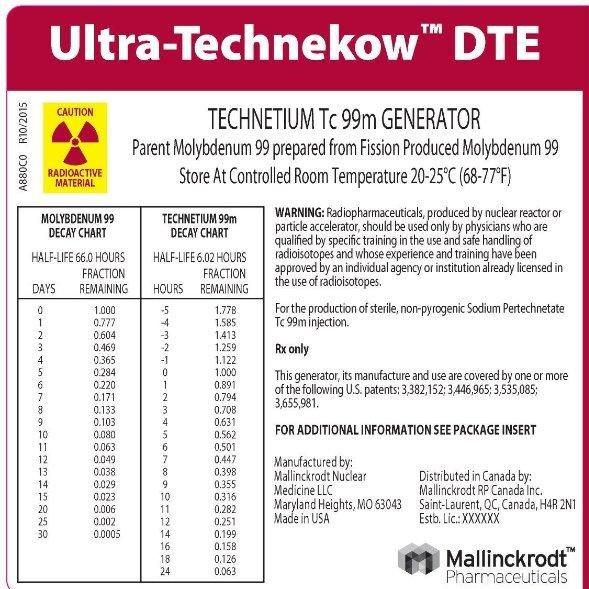
- Principal Display Panel - 1.5 Ci
- Principal Display Panel - 2 Ci
- Principal Display Panel - 2.5 Ci
- Principal Display Panel - 3 Ci
- Principal Display Panel - 3.5 Ci
- Principal Display Panel - 5 Ci
- Principal Display Panel - 6 Ci
- Principal Dispaly Panel - 7.5 Ci
- Principal Display Panel - 11 Ci
- Principal Display Panel - 14 Ci
- Principal Display Panel - 16 Ci
- Principal Display Panel - 19 Ci
-
INGREDIENTS AND APPEARANCE
ULTRA-TECHNEKOW DTE
technetium tc-99m injection, solutionProduct Information Product Type HUMAN PRESCRIPTION DRUG Item Code (Source) NDC: 69945-883 Route of Administration INTRAVENOUS Active Ingredient/Active Moiety Ingredient Name Basis of Strength Strength TECHNETIUM TC-99M SODIUM PERTECHNETATE (UNII: A0730CX801) (TECHNETIUM TC-99M PERTECHNETATE - UNII:PPP8783IQ1) MOLYBDENUM MO-99 1 Ci Packaging # Item Code Package Description Marketing Start Date Marketing End Date 1 NDC: 69945-883-03 1 in 1 CARTON; Type 0: Not a Combination Product Marketing Information Marketing Category Application Number or Monograph Citation Marketing Start Date Marketing End Date NDA NDA017243 12/07/2015 ULTRA-TECHNEKOW DTE
technetium tc-99m injection, solutionProduct Information Product Type HUMAN PRESCRIPTION DRUG Item Code (Source) NDC: 69945-884 Route of Administration INTRAVENOUS Active Ingredient/Active Moiety Ingredient Name Basis of Strength Strength TECHNETIUM TC-99M SODIUM PERTECHNETATE (UNII: A0730CX801) (TECHNETIUM TC-99M PERTECHNETATE - UNII:PPP8783IQ1) MOLYBDENUM MO-99 1.5 Ci Packaging # Item Code Package Description Marketing Start Date Marketing End Date 1 NDC: 69945-884-04 1 in 1 CARTON; Type 0: Not a Combination Product Marketing Information Marketing Category Application Number or Monograph Citation Marketing Start Date Marketing End Date NDA NDA017243 12/07/2015 ULTRA-TECHNEKOW DTE
technetium tc-99m injection, solutionProduct Information Product Type HUMAN PRESCRIPTION DRUG Item Code (Source) NDC: 69945-885 Route of Administration INTRAVENOUS Active Ingredient/Active Moiety Ingredient Name Basis of Strength Strength TECHNETIUM TC-99M SODIUM PERTECHNETATE (UNII: A0730CX801) (TECHNETIUM TC-99M PERTECHNETATE - UNII:PPP8783IQ1) MOLYBDENUM MO-99 2 Ci Packaging # Item Code Package Description Marketing Start Date Marketing End Date 1 NDC: 69945-885-05 1 in 1 CARTON; Type 0: Not a Combination Product Marketing Information Marketing Category Application Number or Monograph Citation Marketing Start Date Marketing End Date NDA NDA017243 12/07/2015 ULTRA-TECHNEKOW DTE
technetium tc-99m injection, solutionProduct Information Product Type HUMAN PRESCRIPTION DRUG Item Code (Source) NDC: 69945-886 Route of Administration INTRAVENOUS Active Ingredient/Active Moiety Ingredient Name Basis of Strength Strength TECHNETIUM TC-99M SODIUM PERTECHNETATE (UNII: A0730CX801) (TECHNETIUM TC-99M PERTECHNETATE - UNII:PPP8783IQ1) MOLYBDENUM MO-99 2.5 Ci Packaging # Item Code Package Description Marketing Start Date Marketing End Date 1 NDC: 69945-886-06 1 in 1 CARTON; Type 0: Not a Combination Product Marketing Information Marketing Category Application Number or Monograph Citation Marketing Start Date Marketing End Date NDA NDA017243 12/07/2015 ULTRA-TECHNEKOW DTE
technetium tc-99m injection, solutionProduct Information Product Type HUMAN PRESCRIPTION DRUG Item Code (Source) NDC: 69945-887 Route of Administration INTRAVENOUS Active Ingredient/Active Moiety Ingredient Name Basis of Strength Strength TECHNETIUM TC-99M SODIUM PERTECHNETATE (UNII: A0730CX801) (TECHNETIUM TC-99M PERTECHNETATE - UNII:PPP8783IQ1) MOLYBDENUM MO-99 3 Ci Packaging # Item Code Package Description Marketing Start Date Marketing End Date 1 NDC: 69945-887-07 1 in 1 CARTON; Type 0: Not a Combination Product Marketing Information Marketing Category Application Number or Monograph Citation Marketing Start Date Marketing End Date NDA NDA017243 12/07/2015 ULTRA-TECHNEKOW DTE
technetium tc-99m injection, solutionProduct Information Product Type HUMAN PRESCRIPTION DRUG Item Code (Source) NDC: 69945-888 Route of Administration INTRAVENOUS Active Ingredient/Active Moiety Ingredient Name Basis of Strength Strength TECHNETIUM TC-99M SODIUM PERTECHNETATE (UNII: A0730CX801) (TECHNETIUM TC-99M PERTECHNETATE - UNII:PPP8783IQ1) MOLYBDENUM MO-99 3.5 Ci Packaging # Item Code Package Description Marketing Start Date Marketing End Date 1 NDC: 69945-888-08 1 in 1 CARTON; Type 0: Not a Combination Product Marketing Information Marketing Category Application Number or Monograph Citation Marketing Start Date Marketing End Date NDA NDA017243 12/07/2015 ULTRA-TECHNEKOW DTE
technetium tc-99m injection, solutionProduct Information Product Type HUMAN PRESCRIPTION DRUG Item Code (Source) NDC: 69945-889 Route of Administration INTRAVENOUS Active Ingredient/Active Moiety Ingredient Name Basis of Strength Strength TECHNETIUM TC-99M SODIUM PERTECHNETATE (UNII: A0730CX801) (TECHNETIUM TC-99M PERTECHNETATE - UNII:PPP8783IQ1) MOLYBDENUM MO-99 5 Ci Packaging # Item Code Package Description Marketing Start Date Marketing End Date 1 NDC: 69945-889-09 1 in 1 CARTON; Type 0: Not a Combination Product Marketing Information Marketing Category Application Number or Monograph Citation Marketing Start Date Marketing End Date NDA NDA017243 12/07/2015 ULTRA-TECHNEKOW DTE
technetium tc-99m injection, solutionProduct Information Product Type HUMAN PRESCRIPTION DRUG Item Code (Source) NDC: 69945-890 Route of Administration INTRAVENOUS Active Ingredient/Active Moiety Ingredient Name Basis of Strength Strength TECHNETIUM TC-99M SODIUM PERTECHNETATE (UNII: A0730CX801) (TECHNETIUM TC-99M PERTECHNETATE - UNII:PPP8783IQ1) MOLYBDENUM MO-99 6 Ci Packaging # Item Code Package Description Marketing Start Date Marketing End Date 1 NDC: 69945-890-10 1 in 1 CARTON; Type 0: Not a Combination Product Marketing Information Marketing Category Application Number or Monograph Citation Marketing Start Date Marketing End Date NDA NDA017243 12/07/2015 ULTRA-TECHNEKOW DTE
technetium tc-99m injection, solutionProduct Information Product Type HUMAN PRESCRIPTION DRUG Item Code (Source) NDC: 69945-891 Route of Administration INTRAVENOUS Active Ingredient/Active Moiety Ingredient Name Basis of Strength Strength TECHNETIUM TC-99M SODIUM PERTECHNETATE (UNII: A0730CX801) (TECHNETIUM TC-99M PERTECHNETATE - UNII:PPP8783IQ1) MOLYBDENUM MO-99 7.5 Ci Packaging # Item Code Package Description Marketing Start Date Marketing End Date 1 NDC: 69945-891-11 1 in 1 CARTON; Type 0: Not a Combination Product Marketing Information Marketing Category Application Number or Monograph Citation Marketing Start Date Marketing End Date NDA NDA017243 12/07/2015 ULTRA-TECHNEKOW DTE
technetium tc-99m injection, solutionProduct Information Product Type HUMAN PRESCRIPTION DRUG Item Code (Source) NDC: 69945-892 Route of Administration INTRAVENOUS Active Ingredient/Active Moiety Ingredient Name Basis of Strength Strength TECHNETIUM TC-99M SODIUM PERTECHNETATE (UNII: A0730CX801) (TECHNETIUM TC-99M PERTECHNETATE - UNII:PPP8783IQ1) MOLYBDENUM MO-99 11 Ci Packaging # Item Code Package Description Marketing Start Date Marketing End Date 1 NDC: 69945-892-12 1 in 1 CARTON; Type 0: Not a Combination Product Marketing Information Marketing Category Application Number or Monograph Citation Marketing Start Date Marketing End Date NDA NDA017243 12/07/2015 ULTRA-TECHNEKOW DTE
technetium tc-99m injection, solutionProduct Information Product Type HUMAN PRESCRIPTION DRUG Item Code (Source) NDC: 69945-893 Route of Administration INTRAVENOUS Active Ingredient/Active Moiety Ingredient Name Basis of Strength Strength TECHNETIUM TC-99M SODIUM PERTECHNETATE (UNII: A0730CX801) (TECHNETIUM TC-99M PERTECHNETATE - UNII:PPP8783IQ1) MOLYBDENUM MO-99 14 Ci Packaging # Item Code Package Description Marketing Start Date Marketing End Date 1 NDC: 69945-893-13 1 in 1 CARTON; Type 0: Not a Combination Product Marketing Information Marketing Category Application Number or Monograph Citation Marketing Start Date Marketing End Date NDA NDA017243 12/07/2015 ULTRA-TECHNEKOW DTE
technetium tc-99m injection, solutionProduct Information Product Type HUMAN PRESCRIPTION DRUG Item Code (Source) NDC: 69945-894 Route of Administration INTRAVENOUS Active Ingredient/Active Moiety Ingredient Name Basis of Strength Strength TECHNETIUM TC-99M SODIUM PERTECHNETATE (UNII: A0730CX801) (TECHNETIUM TC-99M PERTECHNETATE - UNII:PPP8783IQ1) MOLYBDENUM MO-99 16 Ci Packaging # Item Code Package Description Marketing Start Date Marketing End Date 1 NDC: 69945-894-14 1 in 1 CARTON; Type 0: Not a Combination Product Marketing Information Marketing Category Application Number or Monograph Citation Marketing Start Date Marketing End Date NDA NDA017243 12/07/2015 ULTRA-TECHNEKOW DTE
technetium tc-99m injection, solutionProduct Information Product Type HUMAN PRESCRIPTION DRUG Item Code (Source) NDC: 69945-895 Route of Administration INTRAVENOUS Active Ingredient/Active Moiety Ingredient Name Basis of Strength Strength TECHNETIUM TC-99M SODIUM PERTECHNETATE (UNII: A0730CX801) (TECHNETIUM TC-99M PERTECHNETATE - UNII:PPP8783IQ1) MOLYBDENUM MO-99 19 Ci Packaging # Item Code Package Description Marketing Start Date Marketing End Date 1 NDC: 69945-895-15 1 in 1 CARTON; Type 0: Not a Combination Product Marketing Information Marketing Category Application Number or Monograph Citation Marketing Start Date Marketing End Date NDA NDA017243 12/07/2015 Labeler - MALLINCKRODT NUCLEAR MEDICINE LLC (079875617) Establishment Name Address ID/FEI Business Operations Mallinckrodt Nuclear Medicine LLC 557570652 ANALYSIS(69945-883, 69945-884, 69945-885, 69945-886, 69945-887, 69945-888, 69945-889, 69945-890, 69945-891, 69945-892, 69945-893, 69945-894, 69945-895) , MANUFACTURE(69945-883, 69945-884, 69945-885, 69945-886, 69945-887, 69945-888, 69945-889, 69945-890, 69945-891, 69945-892, 69945-893, 69945-894, 69945-895)
Trademark Results [Ultra-TechneKow]
Mark Image Registration | Serial | Company Trademark Application Date |
|---|---|
 ULTRA-TECHNEKOW 72361585 0927758 Live/Registered |
MALLINCKRODT CHEMICAL WORKS 1970-06-03 |
© 2025 FDA.report
This site is not affiliated with or endorsed by the FDA.
